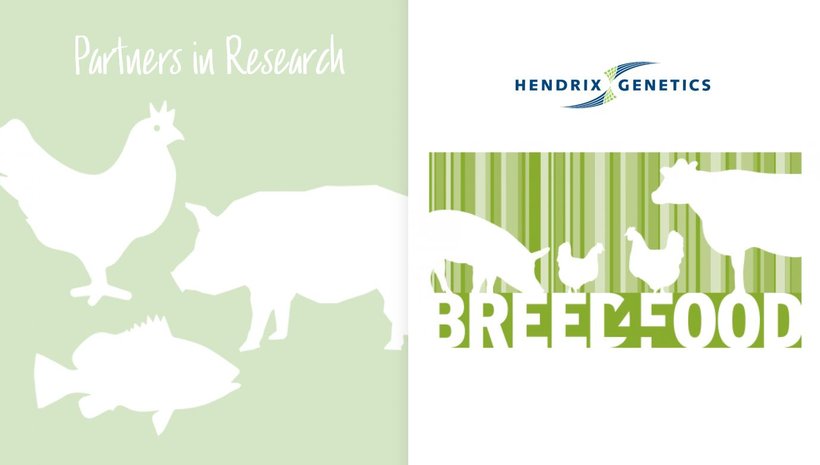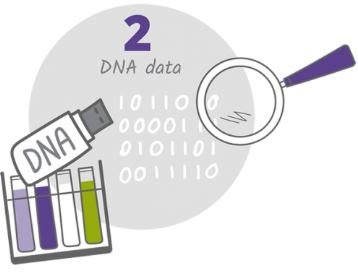
Published on Nov. 16, 2022
Partners in Research: Breed4Food
Four Dutch-based animal breeding companies (TOPIGS, CRV, Hendrix Genetics and Cobb Europe) are prominent global players in animal breeding. These companies, in collaboration with the Animal Breeding and Genomics Group of Wageningen University & Research, work together in Breed4Food. Partners in Breed4Food have the ambition to jointly develop a world-leading institute for research and innovation in livestock genetics, Breed4Food in the Netherlands. Thereby expanding the position of the companies in the world market and strengthening the scientific position of Wageningen UR., to remain world leader in genetics and genomics research. Breed4Food enables the 4 breeding companies to run a breeding program that clearly outperforms the competition. Joint development of pre-competitive knowledge is crucial to achieve the goals of Breed4Food.
With our partnership in Breed4Food, our goal is to strengthen the position of companies worldwide by accelerating the innovation and impact of their breeding programs. The coming period has five different working domains, four of which are aimed at improving and innovating breeding programs: Core engine genomic production, DNA data, Phenotype data, Breeding program optimization and Dialogue with society.

Core engine for genomic prediction
Genomic prediction is the state-of-the-art method used for genetic evaluations in modern breeding schemes. Embraced by all Breed4Food partners, genomic prediction evaluations are routinely performed using available phenotypes, pedigree, and genotypes, to provide the latest and most accurate breeding values for selection candidates. Given this crucial role of genomic prediction, and with the increasing amounts of phenotypes and genotypes, this work package (WP1) “Core engine for genomic prediction” aims to deliver state-of-the-art fast and reliable statistical methods, that are implemented in MiXBLUP, that is a stable software for very large genetic evaluations.
All breeding companies use software, pipelines and models as their core engine for routine genetic evaluations in their breeding schemes. These genetic evaluations need to provide accurate and unbiased breeding values for selection candidates, at a weekly or even daily basis. The state-of-the-art method for these routine genetic evaluations is currently the so-called single-step genomic Best Linear Unbiased Prediction, that analyzes simultaneously phenotypic, pedigree and genomic evaluations. Given its crucial role in animal breeding companies, research to innovate this core engine has been massive both in terms of software and model developments in the past 15 years. The Breed4Food consortium has been a global leading center in this area. Research and development within the Breed4Food consortium were consolidated in MiXBLUP (www.mixblup.eu), a versatile software for large genomic evaluations. While major developments have been successfully implemented, further innovations are continuously needed, to accommodate faster evaluations able to run on the newest infrastructure and to meet the current deadlines, especially with the continuously increasing phenotypic and genomic datasets. Other developments include single-step genomic evaluations for multiple breeds and crossbreds, and computation of the reliability of the estimated genomic breeding values.

DNA informed breeding
Genomic selection has enhanced the genetic gain of the breeding programs at all Breed4Food partners. Genomic selection exploits information based on a few percent of variants at single nucleotides (SNP) across the whole genome. However, there is more variation and information in the genome. Advances in genomics and molecular biology, such as massive sequencing and genotyping technologies, offer unprecedented possibilities to get more insight into the effect of specific mutations and functionality of genes. Understanding the biology of the genome is expected to enhance DNA-informed breeding and enable more accurate genomic prediction. Therefore, promising approaches to identify and use the additional DNA information that is becoming available is investigated within WP2 “DNA informed breeding”.
In WP2 “DNA informed breeding” promising approaches are investigated to identify and use the additional DNA information that is becoming available due to advances in genomics and molecular biology. In addition to SNP variants, all other types of variation will be collected from data sets available from the breeding companies. This so called structural variation in genomes is more likely to have functional impact than SNP, because it covers a larger percentage of the genome and often disrupts genes or other functional elements. Therefore, WP2 will investigate how to derive structural variation from different sources of genotype and sequence information, analyze their impact on phenotypes and find ways to incorporate structural variation in genomic prediction models, together with WP1. New breed-specific reference genomes will become available to form a collection of Pan-genomes for each species. How these new reference genomes can capture all structural variation present in the genomes in a better way will be explored. Individuals with uncommon DNA information can be very relevant to maintain the genetic diversity in breeding populations (WP4), therefore WP2 focusses on identifying individuals with uncommon DNA profiles. Finally, breeding programs deal with trade-offs between unfavourably correlated traits using a selection index. WP2 will explore methods to disentangle causality information between correlated traits using DNA information.

Phenotyping interface
The success of a breeding program depends on the implementation of the most appropriate breeding goal, including consumer and societal demands, and the efficiency in which this breeding goal is achieved. Genomic prediction (WP1) is the core engine of modern breeding programs, which involves software and statistical method developments that are needed to perform state-of-art genomic predictions for an increasing number of genotypes and phenotypic traits.
Technologies for (near) real-time phenotyping are increasingly available on a large scale. These technologies generate high-frequent, high-dimensional longitudinal data and open up the opportunity for developing new phenotypes. However, before these new phenotypes can enter the genomic prediction pipeline, new tools and methods are needed to reduce dimensions, or to capture the frequent measures into a time frame useful for the breeding goal. WP3 “Phenotyping interface” is all about developing such new tools and methods.
Although the implementation of genomic prediction may have reduced the required numbers of phenotypes to be collected for conventional traits, it also opened up the opportunity to select for novel traits, for which recording is relatively scarce or difficult. Using state-of-the-art technologies, the frequency of real-time phenotyping is rapidly increasing from one record per parity, to several records during the parity, to daily recording or even recording every hour or even every second. Especially if the number of recorded animals is limited, it is very important that the generated data is used to its full extent. WP3 aims to develop new models and methodologies that can generate sensible phenotypes with a usable format and scale from high-frequent, high-dimensional longitudinal data. These newly developed tools and methods will contribute to the reduction of data dimensions, to evaluate and determine the effect of using aggregated longitudinal environmental data, and to incorporate this information into genomic prediction models used within breeding programs.

Genomic breeding program optimization
The success of a breeding program depends not only on implementing the most appropriate breeding goal, considering both consumer and societal demands, but also to efficiently achieve this. When doing so, it is important to achieve genetic gain while limiting the rate of inbreeding and controlling the costs of the breeding program. The breeding programs of the Breed4Food partners all use genomic selection.
Thus, and important aspect of optimizing their breeding program involves selecting animals to be phenotyped and genotyped.
Genomic prediction (WP1) is the core engine of modern breeding programs. Efficiently feeding this engine, while maximizing the generated genetic gain per unit of cost, both in the short and long term, is a key challenge. WP4 aims to contribute to this challenge, by generating tools to optimize the design of genomic breeding programs.
The developed tools not only enable to optimize breeding programs for breeding goal traits that remain important over time, but also support short-term operation level changes to provide flexibility to meet changes in societal or market needs. An important challenge is to maintain the genetic diversity in the breeding populations at such a level that long-term genetic gain is safeguarded. To this end, WP4 also aims to develop tools to select outcross and rare haplotypes as well as animals.

Ethics & Society
Animal breeding activities are performed in a sensitive domain since it involves animals. Society / the public has views and opinions on applied techniques of breeding companies, and on the outcomes of genetic selection. In this field, also ethical questions for the companies themselves may rise. Breed4Food has initiated a work package (WP5 “Ethics and society”) to address societal and ethical challenges the animal breeding sector is facing. The main aim is to increase societal and ethical awareness of the partner organisations of Breed4Food and to connect more intensively to societal stakeholders.
Exploring, learning and discussing these kinds of topics together is the main point of this work package. No fundamental research will be conducted, existing expertise will be collected from literature and by consulting experts. Interactivity is the core method to be applied: starting within the companies, and increasingly with the outside world (involving stakeholders). In the first phase, the focus will be on the societal orientation. From the second year onwards, this will be combined with ethical reflection.



